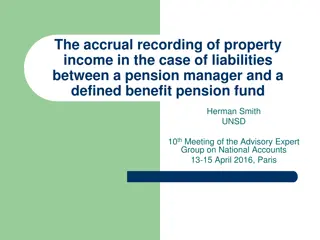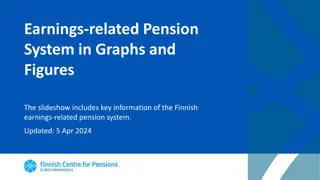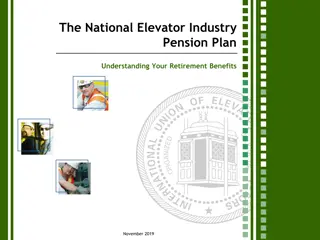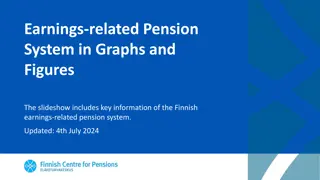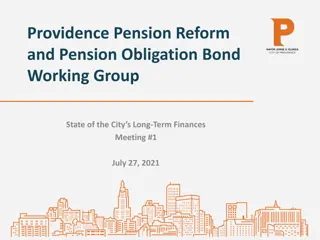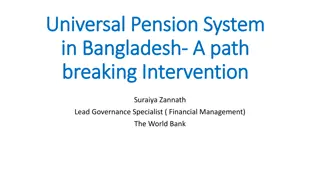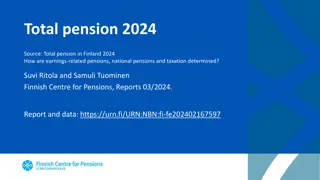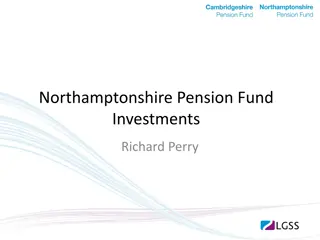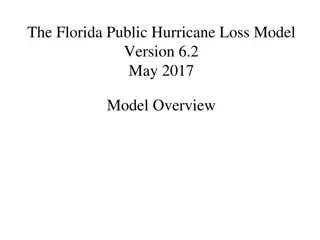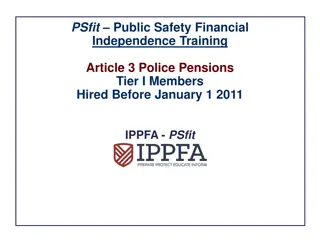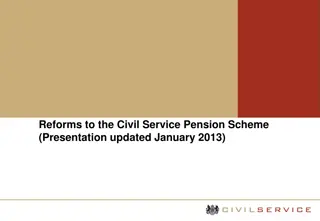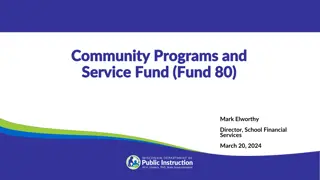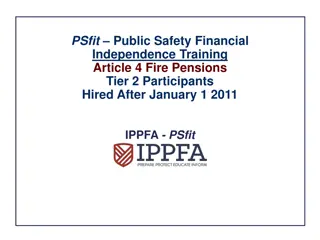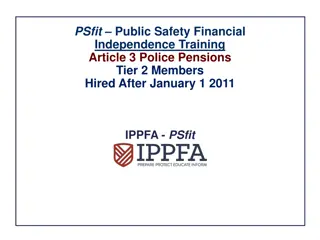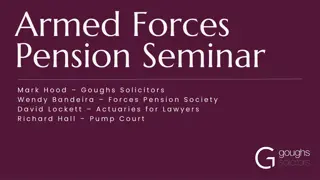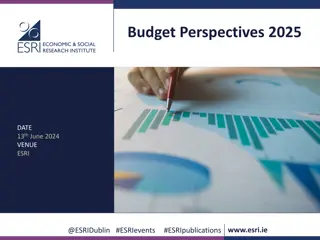Florida Municipal Pension Trust Fund Overview
Providing professional retirement and benefit programs, the Florida Municipal Pension Trust Fund (FMPTF) offers valuable oversight of investments, low fees, and options such as Traditional vs. Roth plans for income replacement. Members can learn about contribution percentages, savings at age 55, and when required minimum distributions start.
Download Presentation

Please find below an Image/Link to download the presentation.
The content on the website is provided AS IS for your information and personal use only. It may not be sold, licensed, or shared on other websites without obtaining consent from the author. Download presentation by click this link. If you encounter any issues during the download, it is possible that the publisher has removed the file from their server.
E N D
Presentation Transcript
Florida Municipal Pension Trust Fund Preparing for Retirement Using your 457(b) Deferred Compensation Plan 1
Agenda What is the FMPTF? How our program provides value Oversight of Investments Low Fees Traditional vs Roth Income Replacement 2
How much should we save, per paycheck, towards retirement? A) 5% B) 10% C) 15% D) 20%
At age 55, how much could you save per year in your 457(b) plan? A) $24,000 B) $18,000 C) $17,500 D) $36,000
At what age do Required Minimum Distributions start? A) 59 1/2 B) 62 C) 67 D) 70 1/2
Florida Municipal Pension Trust Fund Established in 1983 Non-profit, tax-exempt entity Collectively manages individually designed employee pension and OPEB plans of Florida municipalities Provides professional and cost-effective retirement and other post employment benefit programs Any agency or political subdivision in Florida may become a member 7
Current Membership 200 Plans 136 13 49 Over 5,000 Participants $580,000,000 in assets Defined Contribution and Deferred Compensation OPEB Defined Benefit 8
Current 401 & 457 Membership Estero Fire District General Avon Park Sanibel Labelle Belle Isle Flagler County Sheriff Live Oak Sarasota Bay Est Program Belleair Beach Florida Atlantic Research Longwood SCR Wastewater Belleair Bluffs Fort White Macclenny Housing Sebring Broward MPO Green Cove Springs Police Malone South Indian WCD Bushnell Greenacres Marianna General South Pasadena Callaway Greenwood Marianna Health & Rehab South Seminole Cape Canaveral Gulf Breeze Mcintosh Southern Manatee Fire Cedar Key High Springs Mexico Beach Space Florida Cedar Key Sewer & Water Holly Hill Micanopy Springfield Cinco Bayou Cottondale Mulberry St. Leo County Line Drainage Oakland Park St. Marks Clermont Cottondale Daytona Beach Oldsmar Tampa County Line Drainage Daytona Beach Shores Pahokee Umatilla Daytona Beach Dunnellon Panama City Port Authority Valparaiso Daytona Beach Shores Eagle Lake Penney Farms Welaka Dunnellon Eatonville Plant City Wellington Eagle Lake Emerald Coast Utilities Ponce Inlet Wewahitchka Eatonville Jupiter Inlet District Redington Beach Winter Garden Emerald Coast Utilities Keys Energy Services Redington Shores Zolfo Springs 9
Advantages of the FMPTF Administered by the Florida League of Cities, a not for profit corporation that is the official organization of municipal governments in Florida. Multiple Layers of Oversight Local Government Membership Extensive Governmental Plan Knowledge Economies of Scale Enhanced Member Service Lower Costs 10
Oversight Board of Trustees The FMPTF is governed and supervised by a five member Board of Trustees made up of elected officials from municipalities participating in the fund. Dominick Montanaro (Chair), Councilman, Satellite Beach Robert Margolis (Vice Chair), Mayor, Wellington Jack Nazario, Vice Mayor, Belleair Bluffs Peter Noble, Councilman, Greenacres Heyward H. Strong, Jr., Mayor Pro-Tem, Valparaiso 11
Oversight Investment Advisory Committee The Investment Advisory Committee is made of respected municipal officials, and advises the FMPTF Board of Trustees. Chairman Robert Bob B. Inzer Clerk of the Courts, Leon County Linda Davidson Finance Director, Boca Raton William Bill Underwood Finance Director, Town of Loxahatchee Groves Francine Ramalgia Assistant City Manager, City of Delray Beach Joseph LoBello Town Manager, Town of Juno Beach Christopher McCullion CFO, City of Orlando Jane Struder Finance Director, City of Palm Beach Bonnie Wise Darrel Thomas Treasurer, City of Weston Finance Director, Hillsborough County 12
Oversight Asset Consulting Group Asset Consulting Group has over 40 years of investment consulting experience. Conflict-free oversight Quarterly monitoring reports posted on FLCretirement.com Detailed analysis of each fund s performance 13
Plan Investments Asset Class Fund Name Symbol Expense Ratio Cash Vanguard Prime Money Market VMRXX 0.10% Stable Value Mellon Stable Value Fund (no symbol) 0.40% Bonds Vanguard Intermediate-Term Bond Index VBILX 0.10% Vanguard Total Bond Market Index Adm VBTLX 0.07% Vanguard Long-term Treasury Adm VUSUX 0.10% Vanguard Inflation Protected Securities VAIPX 0.10% Balanced Vanguard Wellington Adm VWENX 0.18% Stock Vanguard Windsor II Adm VWNAX 0.28% Vanguard Institutional Index Inst VINIX 0.04% Vanguard PrimeCap Adm VPMAX 0.35% Vanguard Small-cap Index Adm VSMAX 0.09% EV Atlanta Capital SMID-Cap I ERASX 0.90% Expense ratios as of 12/28/2009 14
Plan Investments Asset Class International Fund Name Vanguard Total International Stock Index Vanguard International Growth Adm Vanguard International Value Vanguard REIT Adm Target Retirement Vanguard Target Retirement Income Vanguard Target Retirement 2010 Vanguard Target Retirement 2015 Vanguard Target Retirement 2020 Vanguard Target Retirement 2025 Vanguard Target Retirement 2030 Vanguard Target Retirement 2035 Vanguard Target Retirement 2040 Vanguard Target Retirement 2045 Vanguard Target Retirement 2050 Vanguard Target Retirement 2055 Symbol VTIAX VWILX VTRIX VGSLX VTINX VTENX VTXVX VTWNX VTTVX VTHRX VTTHX VFORX VTIVX VFIFX VFFVX Expense Ratio 0.14% 0.34% 0.44% 0.12% 0.16% 0.16% 0.16% 0.16% 0.17% 0.17% 0.18% 0.18% 0.18% 0.18% 0.18% Real Estate Expense ratios as of 12/28/2009 15
Plan Investments If the investment choices sound scary, consider the Vanguard Target Retirement Funds. Designed to set it and forget it Rebalances, reallocates and diversifies on its own Invested appropriately for your age and becomes more conservative as you grow closer to retirement 16
Target Funds Vs Other Options Managed Account Fees are higher 40bps or more Plus investment expense of possibly higher actively managed funds Have to provide information about yourself Should be a complex investor Annuity or Guaranteed Account Internal fees known as spreads inside account Takes 5-10 years to liquidate Is 2.5%-4.5% return over a 15 to 30 year period really adequate to save for retirement? 17
Fees Most plans have between one and three layers of fees. When reviewing providers, you should be looking at the overall cost of participation. FMPTF Plan Fees Example Provider Participant Fees Administration Fees Investment Expenses The comparison of these two plans may not be clear until you assess the impact on an average participant account. $16 per year 0.40% per year 0.20% on average $0 $0 1.20% on average 18
Fees Now review the impact of the quarterly fees on various participant account balances: Participant Fees Administration Fees Investment Expenses $1,000 balance $5,000 balance $10,000 balance $25,000 balance $100,000 balance $250,000 balance FMPTF Plan Fees $16 per year 0.40% per year 0.17% per year* Example 1 $0 $0 1.20% per year Example 2 $0 0.0% per year 2.00% per year FMPTF Fees $22 $45 $73 $159 $586 $1,441 Example 1 Fees $12 $60 $120 $300 $1,200 $3,000 Example 2 Fees $20 $100 $200 $500 $2,000 $5,000 * Vanguard Funds 19
Fees FMPTF vs. 1.2% vs. 2.0% in fees $300,000.00 $250,000.00 $200,000.00 $150,000.00 $100,000.00 $50,000.00 $- 1 2 3 4 5 6 7 8 9 10 11 12 13 14 15 16 17 18 19 20 21 22 23 24 25 26 27 28 29 30 31 32 33 34 35 $200 a month, 6% return before fees = $248,000 vs. $218,000 vs. $184,000 20
Traditional Vs Roth Traditional also known as Pre-tax or Tax Deferred Roth is After-tax or Post Tax Roth generally is better if: Contributions are larger Start Roth earlier in your career Know you are going to be in higher tax bracket in retirement (Most people are in the same or a lower income tax bracket in retirement) 21
Traditional NOW: Pay no income taxes on contributions in working years LATER: Pay taxes when you withdraw in retirement Money going in (contributions): Pre-tax contributions are deducted from your salary before taxes are taken. That can reduce your taxable income. Earnings, if any: Are tax-deferred until withdrawn. Money coming out (distributions): Distributions are taxable as current income when withdrawn. Required minimum distributions (RMD): The IRS requires distributions to begin at the later of age 70 or retirement. 22
Roth NOW: Pay income taxes on contributions as you make them LATER: Withdraw Savings Tax Free Money going in (contributions): After-tax contributions are subject to federal income tax withholding. Earnings, if any: Are tax-free as long as certain qualifying conditions are met (see below) Money coming out (distributions): Tax-free distributions, as long as you ve satisfied the five-year holding period and are age 59 1/2 or older (assuming you have separated from service), disabled or deceased. Required minimum distributions (RMD): The IRS requires distributions to begin at the later of age 70 or retirement. However, you can roll over your Roth 457(b) to a Roth IRA, where minimum distributions are not required. 23
Examples Leo (Age 45) Lindsay (Age 25) Traditional Roth Traditional Roth Gross Income $35,000 $35,000 Gross Income $50,000 $50,000 Annual Salary able to save $3,000 $3,000 Annual Salary able to save $10,000 $10,000 Taxes at 25% -$0 -$750 Taxes at 25% -$0 -$2,500 Net Yearly Contribution (total over 40 yrs) $120,000 $90,000 Net Yearly Contribution (total over 20 yrs) $200,000 $150,000 Value at end $478,200 $358,700 Value at end $378,900 $284,200 Taxes at 33% -$159,500 -$0 Taxes at 15% -$56,800 -$0 After Tax $322,100 $284,200 After Tax $318,700 $358,700 24
Examples Continued Daniel (Age 50) Courtney (Age 55) Traditional Roth Traditional Roth Gross Income $60,000 $60,000 Gross Income $75,000 $75,000 Annual Salary able to save $6,000 $6,000 Annual Salary able to save $24,000 $30,000 Taxes at 25% -$0 -$6,000 Taxes at 25% -$0 -$1,500 Net Yearly Contribution (total over 15 yrs) $360,000 $360,000 Net Yearly Contribution (total over 10 yrs) $60,000 $45,000 Value at end $576,617 $576,617 Value at end $81,500 $61,100 Taxes at 25% -$144,150 -$0 Taxes at 25% -$20,400 -$0 After Tax $432,457 $576,617 After Tax $61,100 $61,000 25
How much do I need to save? Replacement of 80-100% of pre-retirement income? Maybe. It depends on: Age - when will Social Security/Medicare kick in? Expenses are the mortgage and cars paid off? Plans travel, shopping, and adventure? Or a quieter retirement? Life expectancy 30-40 years in retirement? 26
How much do I need to save? Your Retirement Team Social security - 401(a) or Florida Retirement System Employer Home equity or Inheritance You! - IRAs and 457(b) - Savings in a bank 27
How much do I need to save? Social security - Average monthly benefit $1,335, but depends on many factors Employer (FRS) - Average final salary x years of service x 1.60% (for most) - Example $40,000 x 20 years x 1.6% = $12,800 annually ($1,067 per month) You! What a $34,000 a year retirement could look like 85% of pre-retirement income - $450 from your own investments $450.00 $1,335.00 $1,067.00 Social Security Employer You
How much can I get? Assuming a 6% return $25/month = $22,000 $250/month = $225,000 $50/month = $45,000 $500/month = $450,000 $100/month = $90,000 What your deferral amount gets you in retirement with a 6% return $500,000.00 $450,000.00 $400,000.00 $350,000.00 $300,000.00 $250,000.00 $200,000.00 $150,000.00 $100,000.00 $50,000.00 $- 1 2 3 4 5 6 7 8 9 10 11 12 13 14 15 16 17 18 19 20 21 22 23 24 25 26 27 28 29 30 $25/month $50/month $100/month $250/month $500/month 29
Is it worth it? Assuming a 6% return $25/month = $22,000 You put it $9,000 $50/month = $45,000 You put in $18,000 $100/month = $90,000 You put in $36,000 $250/month = $225,000 You put in $90,000 $500/month = $450,000 You put in $180,000 30
Contact Rodney Walton Account Representative 813-340-7545 rwalton@flcities.com www.flcretirement.com 32


